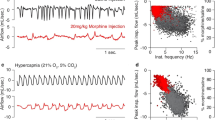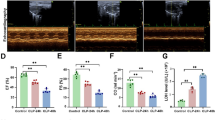Abstract
Recent studies have shown a significant increase of inositol phosphates (IPs) in skeletal muscle during episodes of halothane-induced malignant hyperthermia (MH) in pigs. After treatment with dantrolene and disappearance of MH crisis the IP concentrations returned to basal levels. In order to examine if the increase of IPs during halothane-induced MH may be related to an enhanced IP synthesis in response to activation of 5-HT2 (5-hydroxytryptamine) receptors, the effects of ritanserin, a selective 5-HT2 receptor antagonist, on IP levels were investigated. Biopsies of skeletal muscle of the hindlimbs were obtained in random order and IPs were determined in homozygous MH-susceptible (MHS) and MH-non-susceptible (MHN) swine in the following order: (1) basal, (2) after treatment with ritanserin (2.0 mg/kg), (3) after halothane challenge (3 vol% for 20 min). Basal concentrations of all IPs were higher in MHS than in MHN swine. Ritanserin did not cause any significant changes of IP levels compared to the basal concentrations in MHS and MHN pigs. In MHS pigs, ritanserin did not prevent a halothane-induced MH-crisis. After halothane challenge, 1,3,4-IP3, 1,3,4,6-IP4 and 1,3,4,5-IP4 levels were increased in MHS (during MH crisis) vs. basal concentrations, whereas no changes were found in MHN pigs. Since the increases of IP levels in MHS pigs during MH crisis found in the present study were comparable to those without pretreatment with ritanserin, shown by recent studies, it may be concluded that ritanserin does not prevent the increase of IPs during a halothane-induced MH. Thus, the present data indicate that increases of IP levels during halothane-induced MH in swine are due to other mechanisms than 5-HT mediated enhancement of IP synthesis.
Similar content being viewed by others
References
Berridge MJ (1993) Inositol triphosphate and calcium signalling. Nature 361:315–325
Berridge MJ, Irvine, RF (1989) Inositol phosphates and cell signalling. Nature 341:197–205
Bhattacharyya BJ, Sokoll MD, Long JP (1991) Effect of DOI on neuromuscular transmission: a microelectrode study. Eur J Pharmacol 195:171–174
Fletcher JE, Calvo PA, Rosenberg H (1993) Phenotypes associated with malignant hyperthermia susceptibility in swine genotyped as homozygous for the ryanodine receptor mutation. Br J Anaesth 71:410–417
Fletcher JE, Tripolitis L, Hubert M, Vita GM, Levitt RC, Rosenberg H (1995) Genotype and phenotype relationships for mutations in the ryanodine receptor in patients referred for diagnosis of malignant hyperthermia. Br J Anaesth 75:307–310
Foster PS (1990) Malignant hyperpyrexia. Int J Biochem 22:1217–1222
Foster PS (1994) The role of phosphoinositide metabolism in Ca2+ signalling of skeletal muscle cells. Int J Biochem 26:449–468
Foster PS, Claudianos C, Gesini E, Hopkinson KC, Denborough M (1989) Inositol 1,4,5-triphosphate phosphatase deficiency and malignant hyperpyrexia in swine. Lancet 2:124–127
Fujii J, Otzu K, Zorzato F, de Leon S, Khanna VK, Weilere JE, O'Brien P, MacLennan DH (1991) Identification of a mutation in porcine ryanodine receptor associated with malignant hyperthermia. Science 253:448–451
Gerdes C, Richter A, Armies R, Löscher W (1992) Increase of serotonin in plasma during onset of halothane-induced malignant hyperthermia in pigs. Eur J Pharmacol 220:91–94
Gronert GA (1980) Malignant hyperthermia. Anesthesiology 53:395–423
Levitt RC, Nouri N, Jedlicka AE, McKusick VA, Mark AR, Shutack JG, Fletcher JE, Rosenberg H, Meyers DA (1991) Evidence for genetic heterogeneity in malignant hyperthermia susceptibility. Genomics 11:543–574
Leysen JE, Gommeren W, van Gompel P, Wynants J, Janssen PFM, Laduron PM (1985) Receptor-binding properties in vitro and in vivo of ritanserin. A very potent and long acting serotonin-S2 antagonist. Mol Pharmacol 27:600–611
Lopez JR, Perez C, Linares N, Allen P, Terzic A (1995) Hypersensitive responses of malignant hyperthermia-susceptible skeletal muscle to inositol 1,4,5-triphosphate induced release of calcium. Naunyn-Schmiedeberg's Arch Pharmacol 352:442–446
Löscher W, Witte U, Fredow G, Ganter M, Bickhardt K (1990a) Pharmacodynamic effects of serotonin (5-HT) receptor ligands in pigs: stimulation of 5-HT2 receptors induces malignant hyperthermia. Naunyn-Schmiedeberg's Arch Pharmacol 341:483–493
Löscher W, Witte U, Fredow G, Traber J, Glaser T (1990b) The behavioural response to 8-OH-DPAT, ipsapirone and the novel 5-HT1A receptor agonist BAY Vq 7813 in the pig. Naunyn Schmiedeberg's Arch Pharmacol 342:271–277
Löscher W, Gerdes C, Richter A (1994) Lack of prophylactic or therapeutic efficacy of 5-HT2A receptor antagonists in halothane-induced porcine malignant hyperthermia. Naunyn-Schmiedeberg's Arch Pharmacol 350:365–374
MacLennan DH, Phillips MS (1992) Malignant hyperthermia. Science 256:789–794
McCarthy TV, Healy JMS, Heffron JJA, Lehane M, Deufel T, Lehmann-Horn F, Farrall M, Johnson K (1990) Localization of the malignant hyperthermia susceptibility locus to human chromosome 19g12–13.2. Nature 343:562–564
Moretti-Rojas I, Ezrailson EG, Birnbaumer L, Entman ML, Garber AJ (1983) Serotonergic and adrenergic regulation of skeletal muscle metabolism in the rat. J Biol Chem 258:121499–121508
Richter A, Gerdes C, Löscher W (1992) Atypical reactions to halothane in a subgroup of homozygous malignant hyperthermia (MH)-susceptible pigs: Indication of a heterogenous genetic basis for the porcine syndrome. Dtsch Tierärztl Wochenschr 99:401–406
Rosenberg H, Fletcher JE (1995) International malignant hyperthermia workshop and symposium. Anesthesiology 82:803–805
Ryan JF, Lopez JR, Sanchez VB, Sreter FA, Allen PD (1994) Myoplasmatic calcium changes precede metabolic and clinical signs of porcine malignant hyperthermia. Anesth Analg 79:1007–1011
Scholz J, Troll U, Schulte am Esch J, Hartung E, Patten M, Sandig P, Schmitz W (1991) Inositol-1,4,5-triphosphate and malignant hyperthermia. Lancet 337:1361
Scholz J, Steinfarth M, Roewer N, Patten M, Troll U, Schmitz W Scholz H, Schulte am Esch J (1993) Biochemical changes in malignant hyperthermia susceptible swine: cyclic AMP, inositol phosphates, alpha1, beta1 and beta2-adrenoceptors in skeletal and cardiac muscle. Acta Anaesthesiol Scand 37:575–583
Steinfath M, Singh S, Scholz J, Becker K, Lenzen C, Wappler F, Köchling A, Roewer N, Schulte am Esch J (1995) C1840-T mutation in the human skeletal muscle ryanodine receptor gene: frequency in northern German families susceptible to malignant hyperthermia and the relationship to in vitro contracture response. J Mol Med 73:35–40
Steinmann CML (1994) A possible role for inositol 1,4,5-trisphosphate (IP3) in malignant hyperthermia. Med Hypotheses 42:190–192
Tonner PH, Scholz J, Richter A, Löscher W, Steinfath M, Wappler F, Wlaz P, Hadji B, Roewer N, Schulte am Esch J (1995) Alterations of inositol polyphosphates in skeletal muscle during porcine malignant hyperthermia. Br J Anaesth 75:467–471
Topel DG, Wilson DG, Weiss GM, Christian LL (1973) Influence of phenoxybenzamine and propranolol on blood serotonin and pH, plasma cortisol and M. longissimus pH and color in swine. J Anim Sci 36:1077–1080
Wappler F, Roewer N, Köchling A, Scholz J, Löscher W Steinfath M, Schulte am Esch J (1996) Effects of the scrotonin2-receptor agonist DOI on skeletal muscle specimen of malignant hyperthermia. Anesthesiology 84:1280–1287
Author information
Authors and Affiliations
Rights and permissions
About this article
Cite this article
Richter, A., Löscher, W., Scholz, J. et al. Effects of the 5-HT2 receptor antagonist ritanserin on halothane-induced increase of inositol phosphates in porcine malignant hyperthermia. Naunyn-Schmiedeberg's Arch Pharmacol 354, 593–597 (1996). https://doi.org/10.1007/BF00170833
Received:
Accepted:
Issue Date:
DOI: https://doi.org/10.1007/BF00170833




